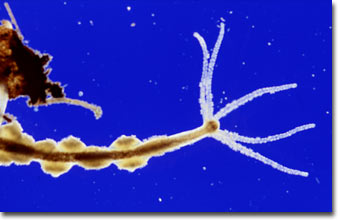Spike (M.I.) Walker
Freshwater Hydra
English photomicrographer Spike (M.I.) Walker has been a consistent winner of the Nikon Small World competition for many years and has published many articles and a book about microscopy. Featured below is a photomicrograph of a freshwater hydra taken with Rheinberg illumination.

|
A male large brown freshwater hydra (Pelmatohydra oligactilis) is captured spreading its tentacles in search of prey. This species has a solid stalk and particularly long tentacles. Note the profusion of testes and the large number of ectocommensal ciliate protozoa (Trichodina pediculus) which were gliding over its surface to give it a 'fuzzy' outline. Illumination was enhanced with Rheinberg contrast filters. The photomicrograph was taken with Zeiss Tessovar zoom macro equipment coupled to a Bowen Illumitran transparency copier utilized as a flash light source, in conjunction with a 2" aspheric condenser. (4.5x) |
Hydras belong to the phylum Coelenterata (also called Cnidaria), which includes corals, sea anemones, and jellyfish. Coelenterates are primarily marine animals, but hydras are found in freshwater ponds, lakes, and streams. Hydras are also atypical because they do not have a medusa (jellyfish) stage as part of their life cycle as do most other coelenterates. They live and reproduce sexually and asexually, but only in the tube-shaped polyp form. However, they do have nematocysts, or cnidae, the microscopic intracellular stinging capsules characteristic of this phylum and for which it is named.
Simple as these organisms are, their nematocysts are one of the most complex structures in the animal world. Hydras have four types of nematocysts on their tentacles, which are used for a variety of purposes. The largest nematocyst has barbs that anchor the prey to the tentacle from which it was fired. With a firm hold on its prey, the hydra then envelopes the organism, like a sock being pulled over a foot, and consumes it. The second type is smaller and has a shorter, thicker corkscrew thread that wraps around and holds onto the prey animal. A third type has a sticky bean-shaped object at its end that is used in locomotion, securing the hydra as it glides or somersaults from one place to another. The fourth kind of nematocyst has spines running along the thread and is probably used to defend the hydra against potential predators.
